Comprehensive Report on Accounting Concepts and Systems in Finance
VerifiedAdded on 2023/01/03
|9
|1958
|91
Report
AI Summary
This report provides a comprehensive overview of fundamental accounting concepts and their significance in financial statement preparation. It discusses key concepts such as the business entity, money measurement, duality, going concern, cost, accounting period, matching, realization, conservatism, and materiality concepts. The report also analyzes the differences between rule-based accounting systems (like GAAP) and principle-based systems (like IFRS), highlighting their approaches to decision-making, legal aspects, flexibility, application, standardization, inventory valuation, and other key areas such as the treatment of inventory reversal, development costs, non-current asset valuation, statement of income, and earnings per share. The report concludes by emphasizing the crucial role of accounting principles in ensuring accurate financial reporting, facilitating investor understanding, and promoting a uniform approach to accounting practices globally.
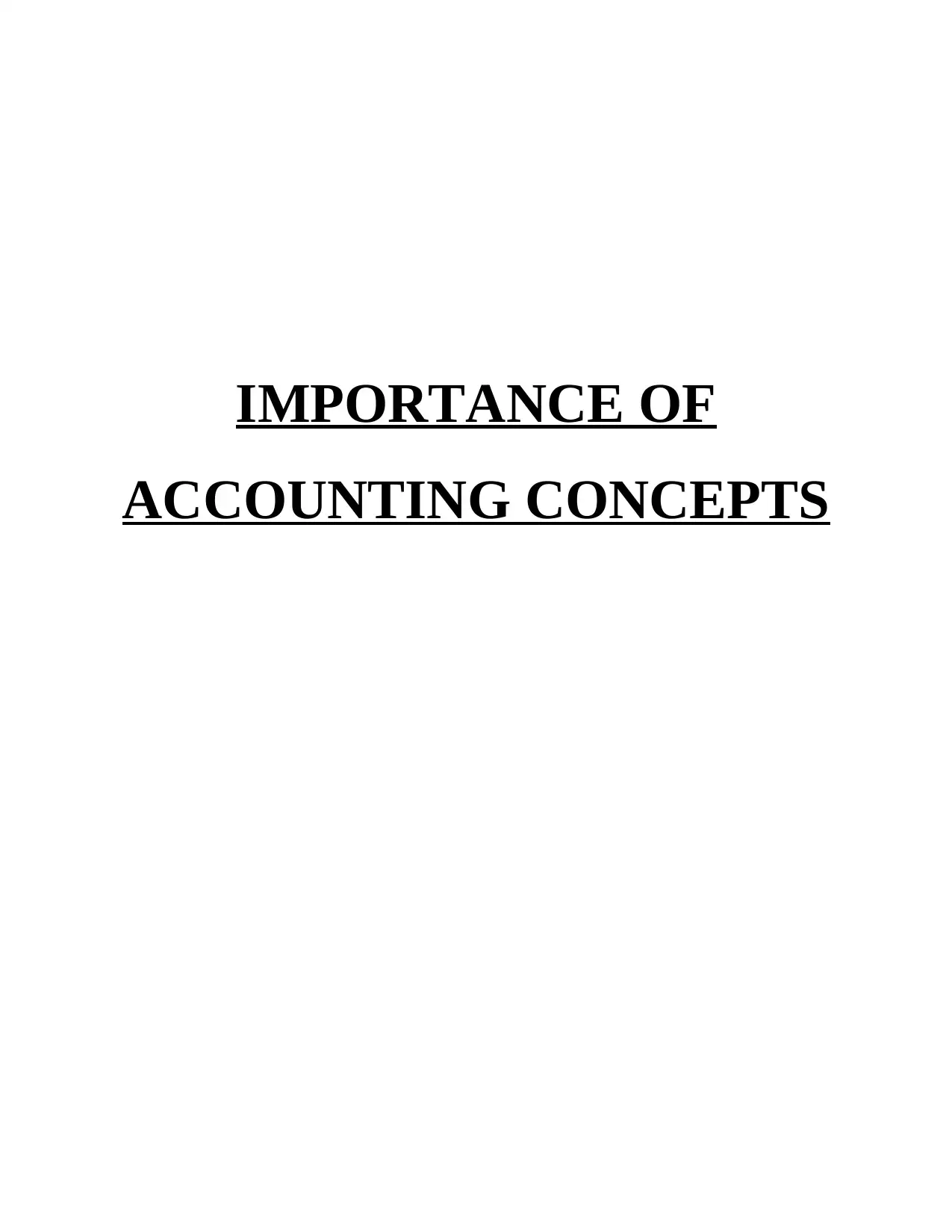
IMPORTANCE OF
ACCOUNTING CONCEPTS
ACCOUNTING CONCEPTS
Paraphrase This Document
Need a fresh take? Get an instant paraphrase of this document with our AI Paraphraser
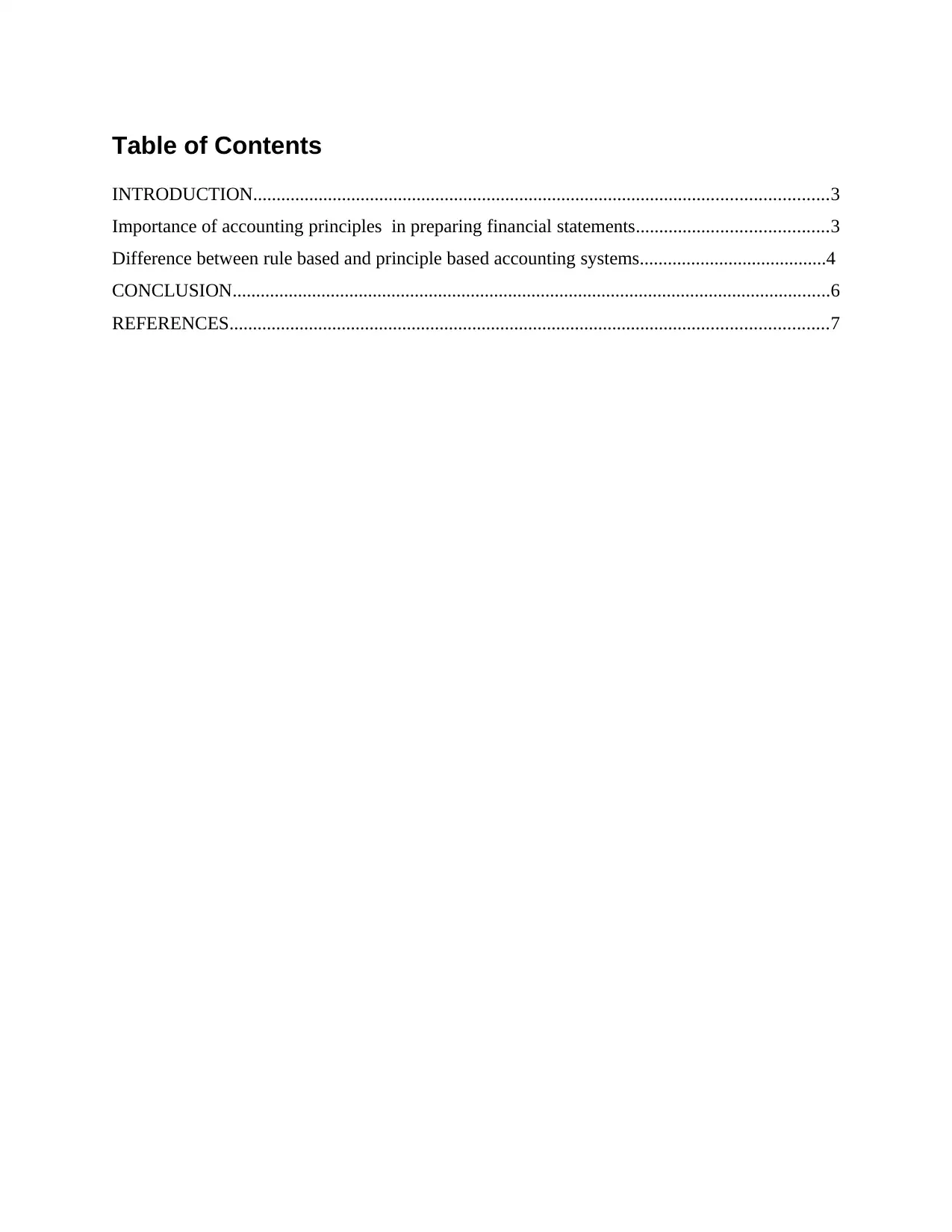
Table of Contents
INTRODUCTION...........................................................................................................................3
Importance of accounting principles in preparing financial statements.........................................3
Difference between rule based and principle based accounting systems........................................4
CONCLUSION................................................................................................................................6
REFERENCES................................................................................................................................7
INTRODUCTION...........................................................................................................................3
Importance of accounting principles in preparing financial statements.........................................3
Difference between rule based and principle based accounting systems........................................4
CONCLUSION................................................................................................................................6
REFERENCES................................................................................................................................7
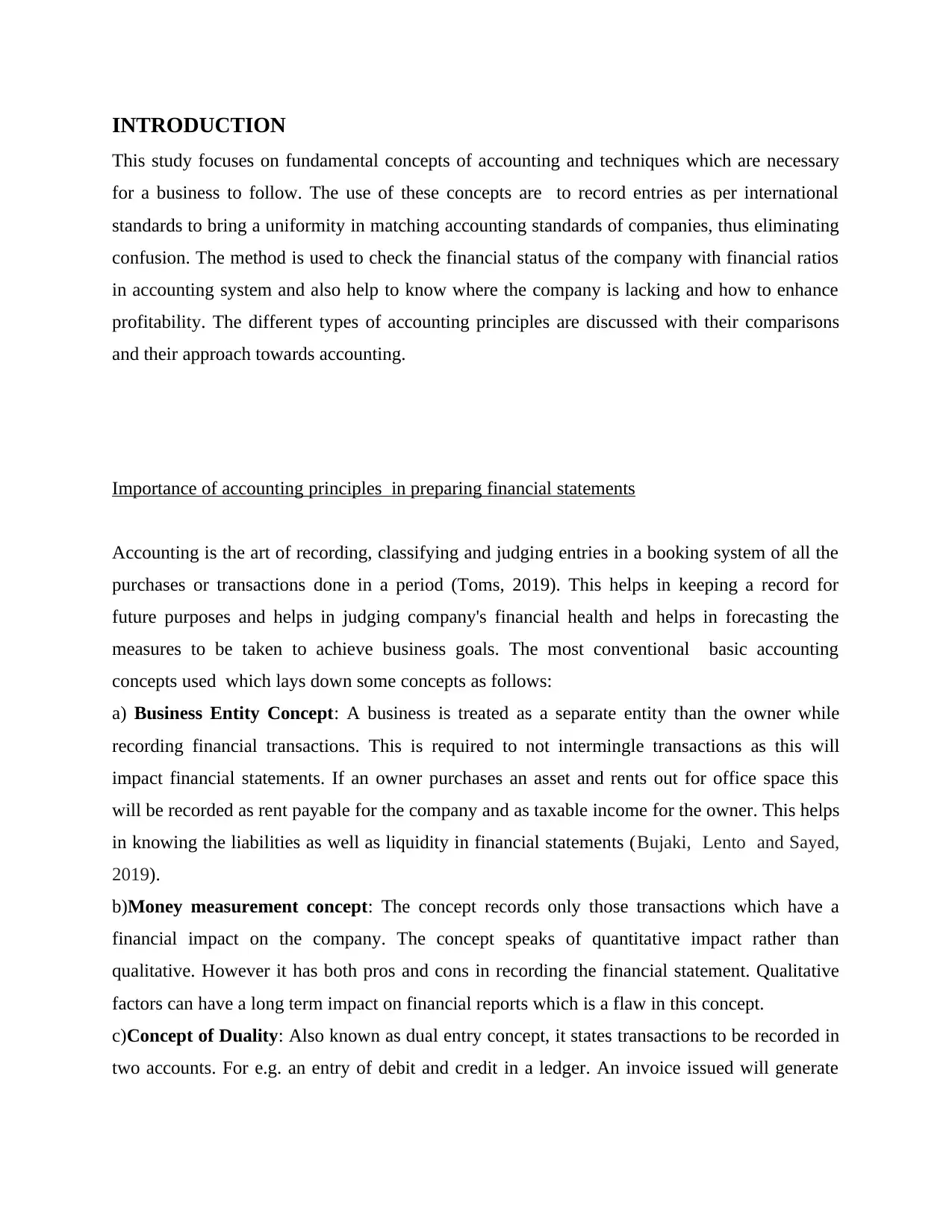
INTRODUCTION
This study focuses on fundamental concepts of accounting and techniques which are necessary
for a business to follow. The use of these concepts are to record entries as per international
standards to bring a uniformity in matching accounting standards of companies, thus eliminating
confusion. The method is used to check the financial status of the company with financial ratios
in accounting system and also help to know where the company is lacking and how to enhance
profitability. The different types of accounting principles are discussed with their comparisons
and their approach towards accounting.
Importance of accounting principles in preparing financial statements
Accounting is the art of recording, classifying and judging entries in a booking system of all the
purchases or transactions done in a period (Toms, 2019). This helps in keeping a record for
future purposes and helps in judging company's financial health and helps in forecasting the
measures to be taken to achieve business goals. The most conventional basic accounting
concepts used which lays down some concepts as follows:
a) Business Entity Concept: A business is treated as a separate entity than the owner while
recording financial transactions. This is required to not intermingle transactions as this will
impact financial statements. If an owner purchases an asset and rents out for office space this
will be recorded as rent payable for the company and as taxable income for the owner. This helps
in knowing the liabilities as well as liquidity in financial statements (Bujaki, Lento and Sayed,
2019).
b)Money measurement concept: The concept records only those transactions which have a
financial impact on the company. The concept speaks of quantitative impact rather than
qualitative. However it has both pros and cons in recording the financial statement. Qualitative
factors can have a long term impact on financial reports which is a flaw in this concept.
c)Concept of Duality: Also known as dual entry concept, it states transactions to be recorded in
two accounts. For e.g. an entry of debit and credit in a ledger. An invoice issued will generate
This study focuses on fundamental concepts of accounting and techniques which are necessary
for a business to follow. The use of these concepts are to record entries as per international
standards to bring a uniformity in matching accounting standards of companies, thus eliminating
confusion. The method is used to check the financial status of the company with financial ratios
in accounting system and also help to know where the company is lacking and how to enhance
profitability. The different types of accounting principles are discussed with their comparisons
and their approach towards accounting.
Importance of accounting principles in preparing financial statements
Accounting is the art of recording, classifying and judging entries in a booking system of all the
purchases or transactions done in a period (Toms, 2019). This helps in keeping a record for
future purposes and helps in judging company's financial health and helps in forecasting the
measures to be taken to achieve business goals. The most conventional basic accounting
concepts used which lays down some concepts as follows:
a) Business Entity Concept: A business is treated as a separate entity than the owner while
recording financial transactions. This is required to not intermingle transactions as this will
impact financial statements. If an owner purchases an asset and rents out for office space this
will be recorded as rent payable for the company and as taxable income for the owner. This helps
in knowing the liabilities as well as liquidity in financial statements (Bujaki, Lento and Sayed,
2019).
b)Money measurement concept: The concept records only those transactions which have a
financial impact on the company. The concept speaks of quantitative impact rather than
qualitative. However it has both pros and cons in recording the financial statement. Qualitative
factors can have a long term impact on financial reports which is a flaw in this concept.
c)Concept of Duality: Also known as dual entry concept, it states transactions to be recorded in
two accounts. For e.g. an entry of debit and credit in a ledger. An invoice issued will generate
⊘ This is a preview!⊘
Do you want full access?
Subscribe today to unlock all pages.

Trusted by 1+ million students worldwide
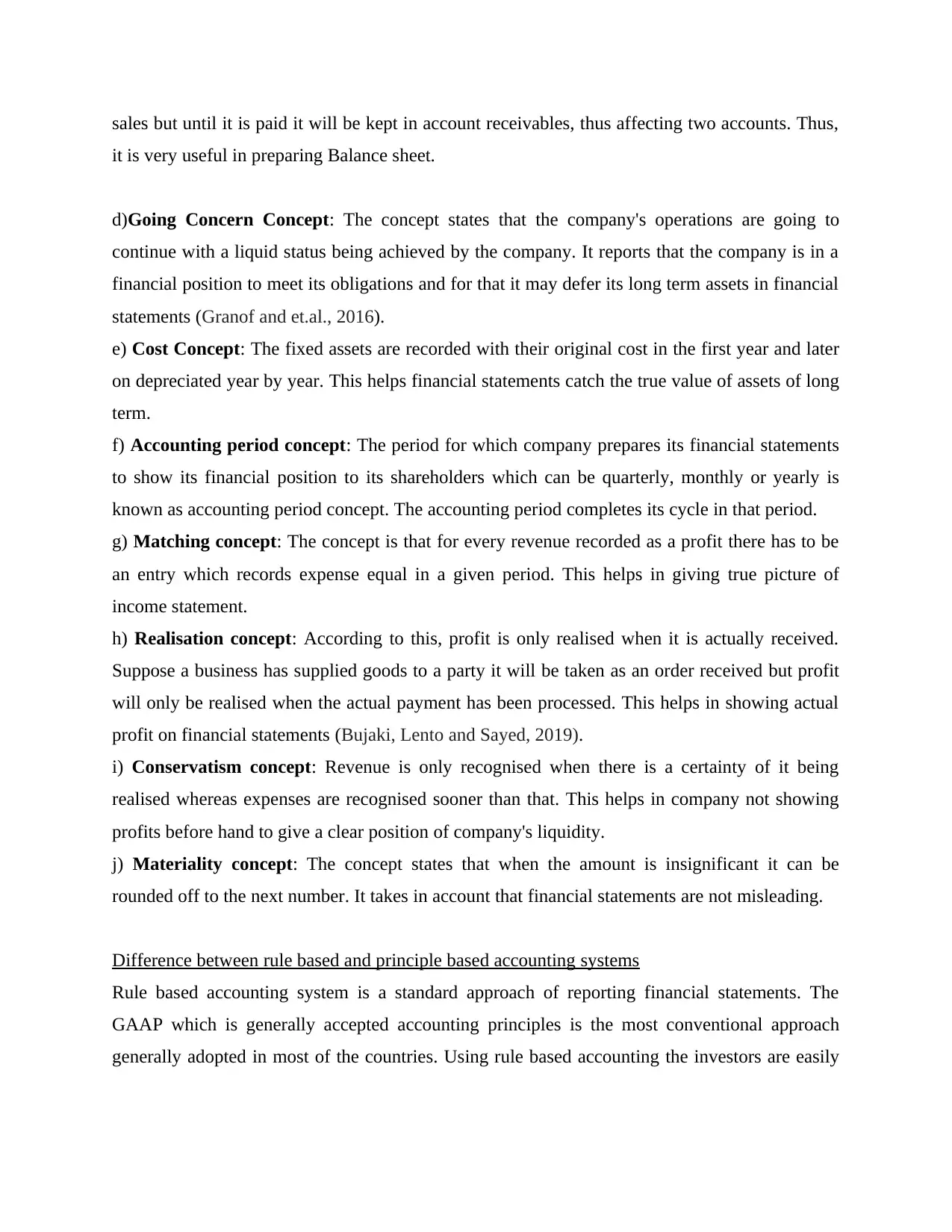
sales but until it is paid it will be kept in account receivables, thus affecting two accounts. Thus,
it is very useful in preparing Balance sheet.
d)Going Concern Concept: The concept states that the company's operations are going to
continue with a liquid status being achieved by the company. It reports that the company is in a
financial position to meet its obligations and for that it may defer its long term assets in financial
statements (Granof and et.al., 2016).
e) Cost Concept: The fixed assets are recorded with their original cost in the first year and later
on depreciated year by year. This helps financial statements catch the true value of assets of long
term.
f) Accounting period concept: The period for which company prepares its financial statements
to show its financial position to its shareholders which can be quarterly, monthly or yearly is
known as accounting period concept. The accounting period completes its cycle in that period.
g) Matching concept: The concept is that for every revenue recorded as a profit there has to be
an entry which records expense equal in a given period. This helps in giving true picture of
income statement.
h) Realisation concept: According to this, profit is only realised when it is actually received.
Suppose a business has supplied goods to a party it will be taken as an order received but profit
will only be realised when the actual payment has been processed. This helps in showing actual
profit on financial statements (Bujaki, Lento and Sayed, 2019).
i) Conservatism concept: Revenue is only recognised when there is a certainty of it being
realised whereas expenses are recognised sooner than that. This helps in company not showing
profits before hand to give a clear position of company's liquidity.
j) Materiality concept: The concept states that when the amount is insignificant it can be
rounded off to the next number. It takes in account that financial statements are not misleading.
Difference between rule based and principle based accounting systems
Rule based accounting system is a standard approach of reporting financial statements. The
GAAP which is generally accepted accounting principles is the most conventional approach
generally adopted in most of the countries. Using rule based accounting the investors are easily
it is very useful in preparing Balance sheet.
d)Going Concern Concept: The concept states that the company's operations are going to
continue with a liquid status being achieved by the company. It reports that the company is in a
financial position to meet its obligations and for that it may defer its long term assets in financial
statements (Granof and et.al., 2016).
e) Cost Concept: The fixed assets are recorded with their original cost in the first year and later
on depreciated year by year. This helps financial statements catch the true value of assets of long
term.
f) Accounting period concept: The period for which company prepares its financial statements
to show its financial position to its shareholders which can be quarterly, monthly or yearly is
known as accounting period concept. The accounting period completes its cycle in that period.
g) Matching concept: The concept is that for every revenue recorded as a profit there has to be
an entry which records expense equal in a given period. This helps in giving true picture of
income statement.
h) Realisation concept: According to this, profit is only realised when it is actually received.
Suppose a business has supplied goods to a party it will be taken as an order received but profit
will only be realised when the actual payment has been processed. This helps in showing actual
profit on financial statements (Bujaki, Lento and Sayed, 2019).
i) Conservatism concept: Revenue is only recognised when there is a certainty of it being
realised whereas expenses are recognised sooner than that. This helps in company not showing
profits before hand to give a clear position of company's liquidity.
j) Materiality concept: The concept states that when the amount is insignificant it can be
rounded off to the next number. It takes in account that financial statements are not misleading.
Difference between rule based and principle based accounting systems
Rule based accounting system is a standard approach of reporting financial statements. The
GAAP which is generally accepted accounting principles is the most conventional approach
generally adopted in most of the countries. Using rule based accounting the investors are easily
Paraphrase This Document
Need a fresh take? Get an instant paraphrase of this document with our AI Paraphraser
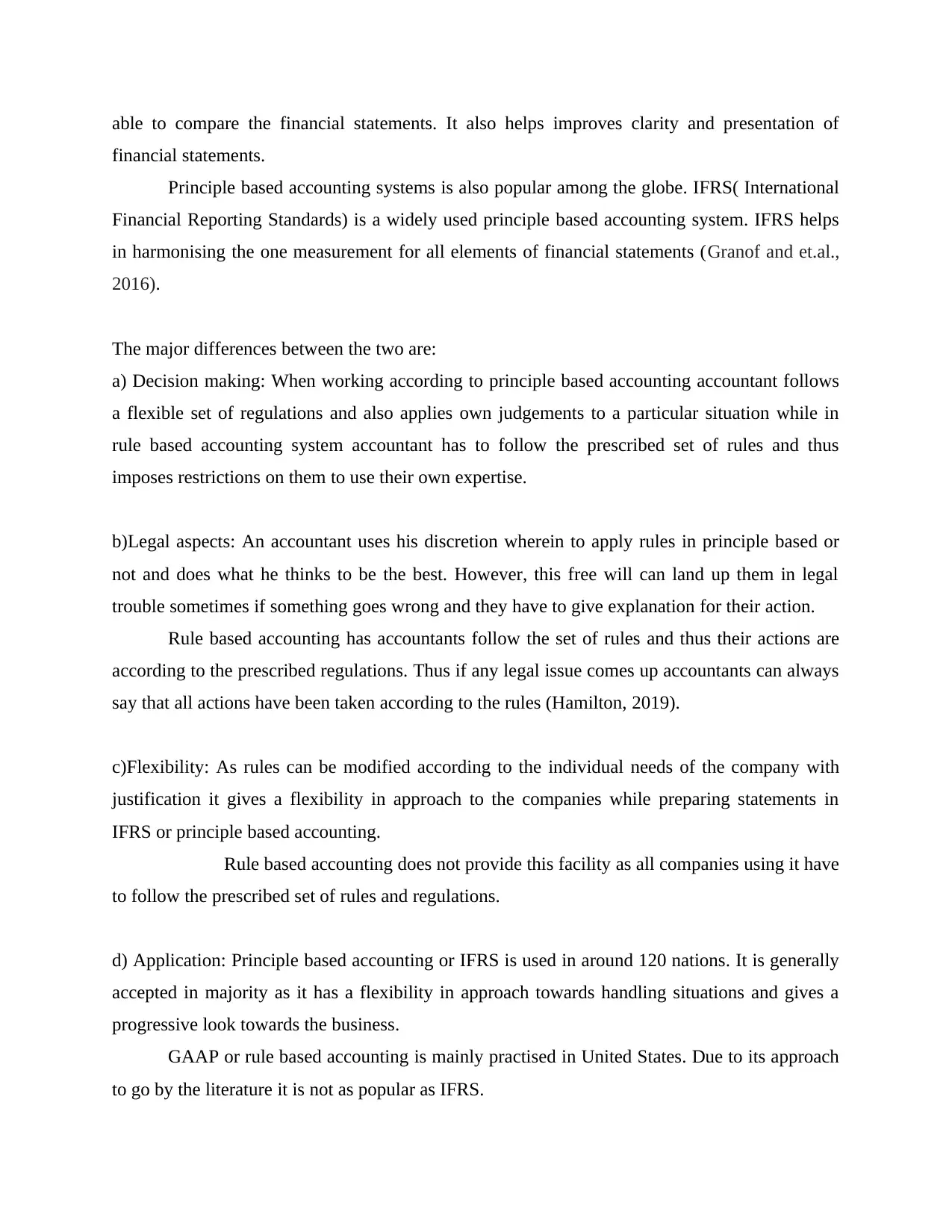
able to compare the financial statements. It also helps improves clarity and presentation of
financial statements.
Principle based accounting systems is also popular among the globe. IFRS( International
Financial Reporting Standards) is a widely used principle based accounting system. IFRS helps
in harmonising the one measurement for all elements of financial statements (Granof and et.al.,
2016).
The major differences between the two are:
a) Decision making: When working according to principle based accounting accountant follows
a flexible set of regulations and also applies own judgements to a particular situation while in
rule based accounting system accountant has to follow the prescribed set of rules and thus
imposes restrictions on them to use their own expertise.
b)Legal aspects: An accountant uses his discretion wherein to apply rules in principle based or
not and does what he thinks to be the best. However, this free will can land up them in legal
trouble sometimes if something goes wrong and they have to give explanation for their action.
Rule based accounting has accountants follow the set of rules and thus their actions are
according to the prescribed regulations. Thus if any legal issue comes up accountants can always
say that all actions have been taken according to the rules (Hamilton, 2019).
c)Flexibility: As rules can be modified according to the individual needs of the company with
justification it gives a flexibility in approach to the companies while preparing statements in
IFRS or principle based accounting.
Rule based accounting does not provide this facility as all companies using it have
to follow the prescribed set of rules and regulations.
d) Application: Principle based accounting or IFRS is used in around 120 nations. It is generally
accepted in majority as it has a flexibility in approach towards handling situations and gives a
progressive look towards the business.
GAAP or rule based accounting is mainly practised in United States. Due to its approach
to go by the literature it is not as popular as IFRS.
financial statements.
Principle based accounting systems is also popular among the globe. IFRS( International
Financial Reporting Standards) is a widely used principle based accounting system. IFRS helps
in harmonising the one measurement for all elements of financial statements (Granof and et.al.,
2016).
The major differences between the two are:
a) Decision making: When working according to principle based accounting accountant follows
a flexible set of regulations and also applies own judgements to a particular situation while in
rule based accounting system accountant has to follow the prescribed set of rules and thus
imposes restrictions on them to use their own expertise.
b)Legal aspects: An accountant uses his discretion wherein to apply rules in principle based or
not and does what he thinks to be the best. However, this free will can land up them in legal
trouble sometimes if something goes wrong and they have to give explanation for their action.
Rule based accounting has accountants follow the set of rules and thus their actions are
according to the prescribed regulations. Thus if any legal issue comes up accountants can always
say that all actions have been taken according to the rules (Hamilton, 2019).
c)Flexibility: As rules can be modified according to the individual needs of the company with
justification it gives a flexibility in approach to the companies while preparing statements in
IFRS or principle based accounting.
Rule based accounting does not provide this facility as all companies using it have
to follow the prescribed set of rules and regulations.
d) Application: Principle based accounting or IFRS is used in around 120 nations. It is generally
accepted in majority as it has a flexibility in approach towards handling situations and gives a
progressive look towards the business.
GAAP or rule based accounting is mainly practised in United States. Due to its approach
to go by the literature it is not as popular as IFRS.
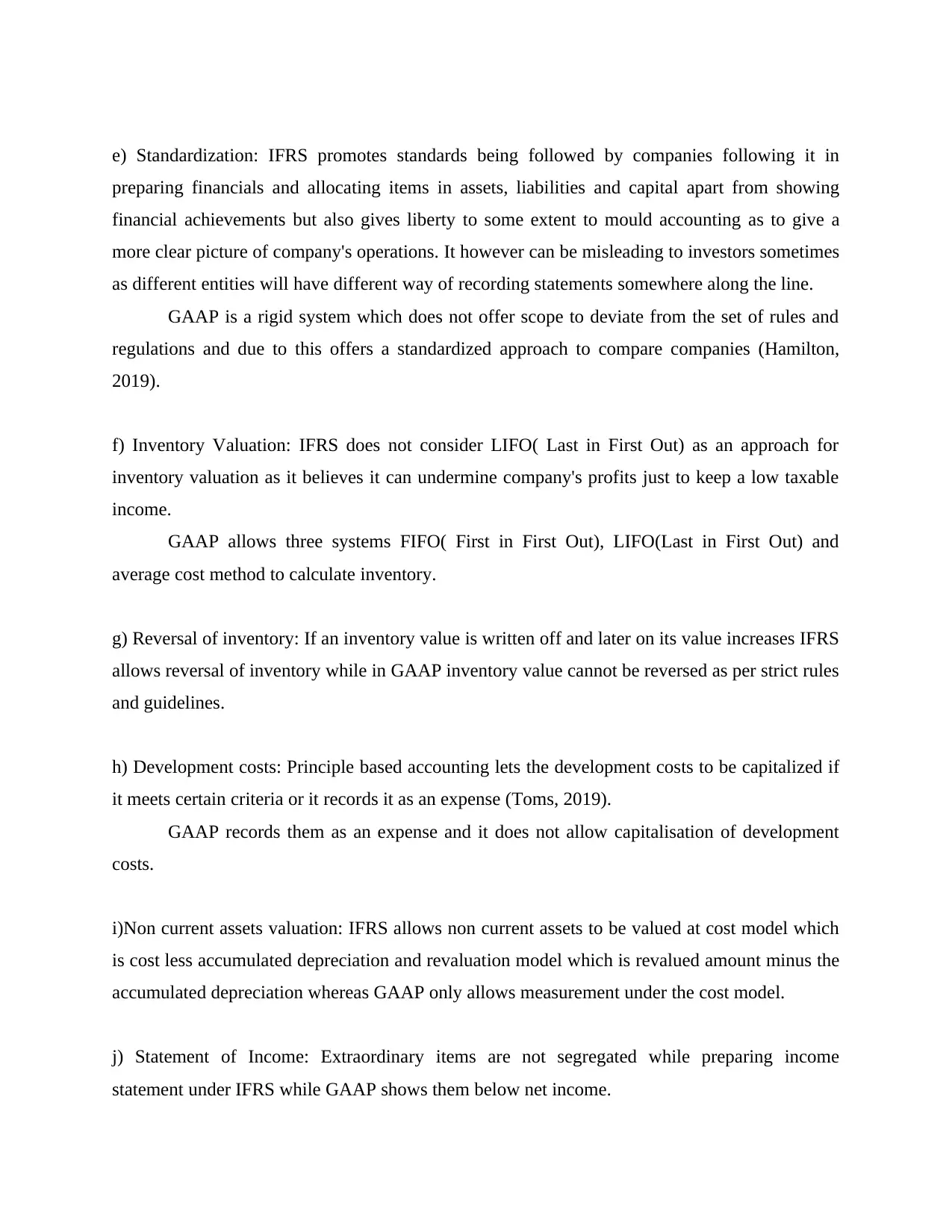
e) Standardization: IFRS promotes standards being followed by companies following it in
preparing financials and allocating items in assets, liabilities and capital apart from showing
financial achievements but also gives liberty to some extent to mould accounting as to give a
more clear picture of company's operations. It however can be misleading to investors sometimes
as different entities will have different way of recording statements somewhere along the line.
GAAP is a rigid system which does not offer scope to deviate from the set of rules and
regulations and due to this offers a standardized approach to compare companies (Hamilton,
2019).
f) Inventory Valuation: IFRS does not consider LIFO( Last in First Out) as an approach for
inventory valuation as it believes it can undermine company's profits just to keep a low taxable
income.
GAAP allows three systems FIFO( First in First Out), LIFO(Last in First Out) and
average cost method to calculate inventory.
g) Reversal of inventory: If an inventory value is written off and later on its value increases IFRS
allows reversal of inventory while in GAAP inventory value cannot be reversed as per strict rules
and guidelines.
h) Development costs: Principle based accounting lets the development costs to be capitalized if
it meets certain criteria or it records it as an expense (Toms, 2019).
GAAP records them as an expense and it does not allow capitalisation of development
costs.
i)Non current assets valuation: IFRS allows non current assets to be valued at cost model which
is cost less accumulated depreciation and revaluation model which is revalued amount minus the
accumulated depreciation whereas GAAP only allows measurement under the cost model.
j) Statement of Income: Extraordinary items are not segregated while preparing income
statement under IFRS while GAAP shows them below net income.
preparing financials and allocating items in assets, liabilities and capital apart from showing
financial achievements but also gives liberty to some extent to mould accounting as to give a
more clear picture of company's operations. It however can be misleading to investors sometimes
as different entities will have different way of recording statements somewhere along the line.
GAAP is a rigid system which does not offer scope to deviate from the set of rules and
regulations and due to this offers a standardized approach to compare companies (Hamilton,
2019).
f) Inventory Valuation: IFRS does not consider LIFO( Last in First Out) as an approach for
inventory valuation as it believes it can undermine company's profits just to keep a low taxable
income.
GAAP allows three systems FIFO( First in First Out), LIFO(Last in First Out) and
average cost method to calculate inventory.
g) Reversal of inventory: If an inventory value is written off and later on its value increases IFRS
allows reversal of inventory while in GAAP inventory value cannot be reversed as per strict rules
and guidelines.
h) Development costs: Principle based accounting lets the development costs to be capitalized if
it meets certain criteria or it records it as an expense (Toms, 2019).
GAAP records them as an expense and it does not allow capitalisation of development
costs.
i)Non current assets valuation: IFRS allows non current assets to be valued at cost model which
is cost less accumulated depreciation and revaluation model which is revalued amount minus the
accumulated depreciation whereas GAAP only allows measurement under the cost model.
j) Statement of Income: Extraordinary items are not segregated while preparing income
statement under IFRS while GAAP shows them below net income.
⊘ This is a preview!⊘
Do you want full access?
Subscribe today to unlock all pages.

Trusted by 1+ million students worldwide
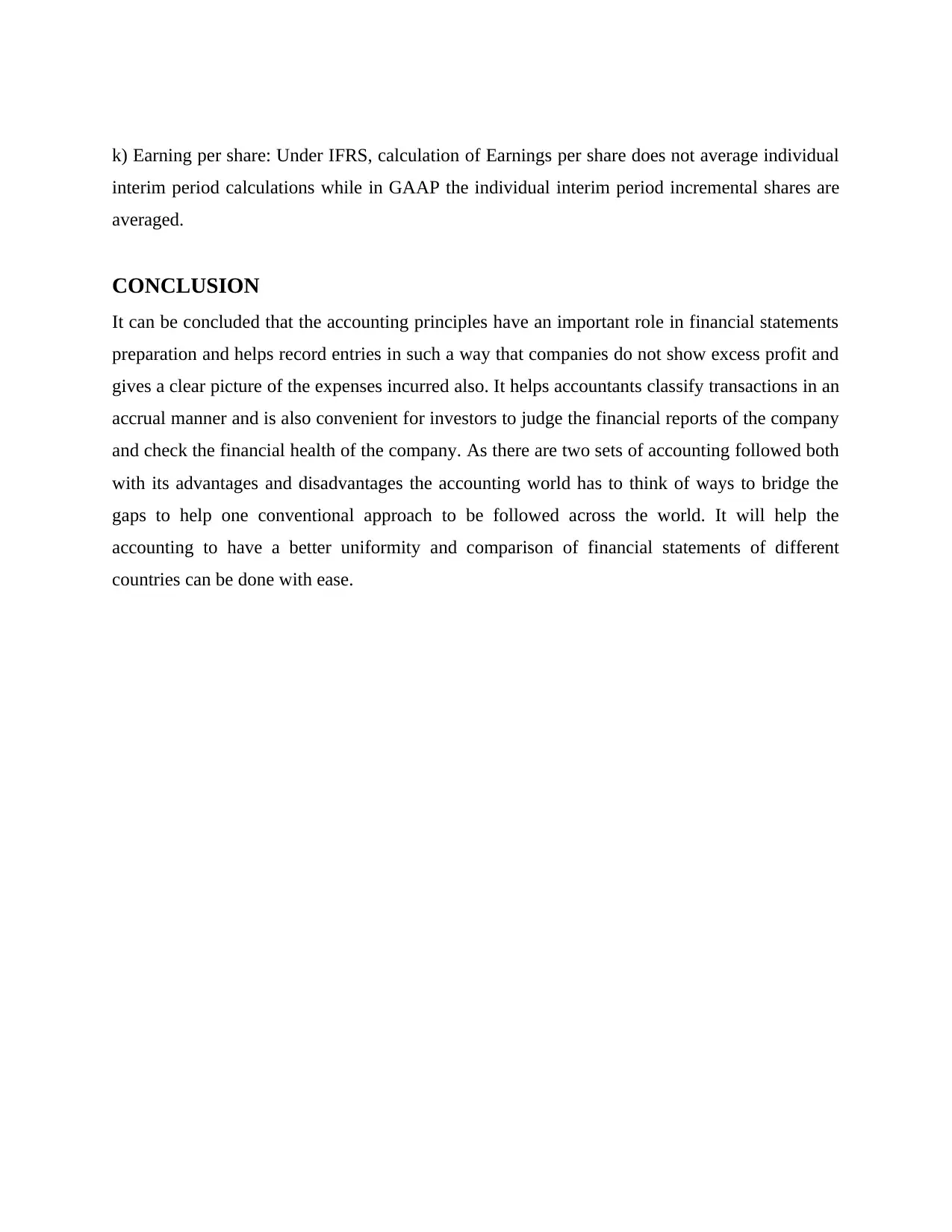
k) Earning per share: Under IFRS, calculation of Earnings per share does not average individual
interim period calculations while in GAAP the individual interim period incremental shares are
averaged.
CONCLUSION
It can be concluded that the accounting principles have an important role in financial statements
preparation and helps record entries in such a way that companies do not show excess profit and
gives a clear picture of the expenses incurred also. It helps accountants classify transactions in an
accrual manner and is also convenient for investors to judge the financial reports of the company
and check the financial health of the company. As there are two sets of accounting followed both
with its advantages and disadvantages the accounting world has to think of ways to bridge the
gaps to help one conventional approach to be followed across the world. It will help the
accounting to have a better uniformity and comparison of financial statements of different
countries can be done with ease.
interim period calculations while in GAAP the individual interim period incremental shares are
averaged.
CONCLUSION
It can be concluded that the accounting principles have an important role in financial statements
preparation and helps record entries in such a way that companies do not show excess profit and
gives a clear picture of the expenses incurred also. It helps accountants classify transactions in an
accrual manner and is also convenient for investors to judge the financial reports of the company
and check the financial health of the company. As there are two sets of accounting followed both
with its advantages and disadvantages the accounting world has to think of ways to bridge the
gaps to help one conventional approach to be followed across the world. It will help the
accounting to have a better uniformity and comparison of financial statements of different
countries can be done with ease.
Paraphrase This Document
Need a fresh take? Get an instant paraphrase of this document with our AI Paraphraser
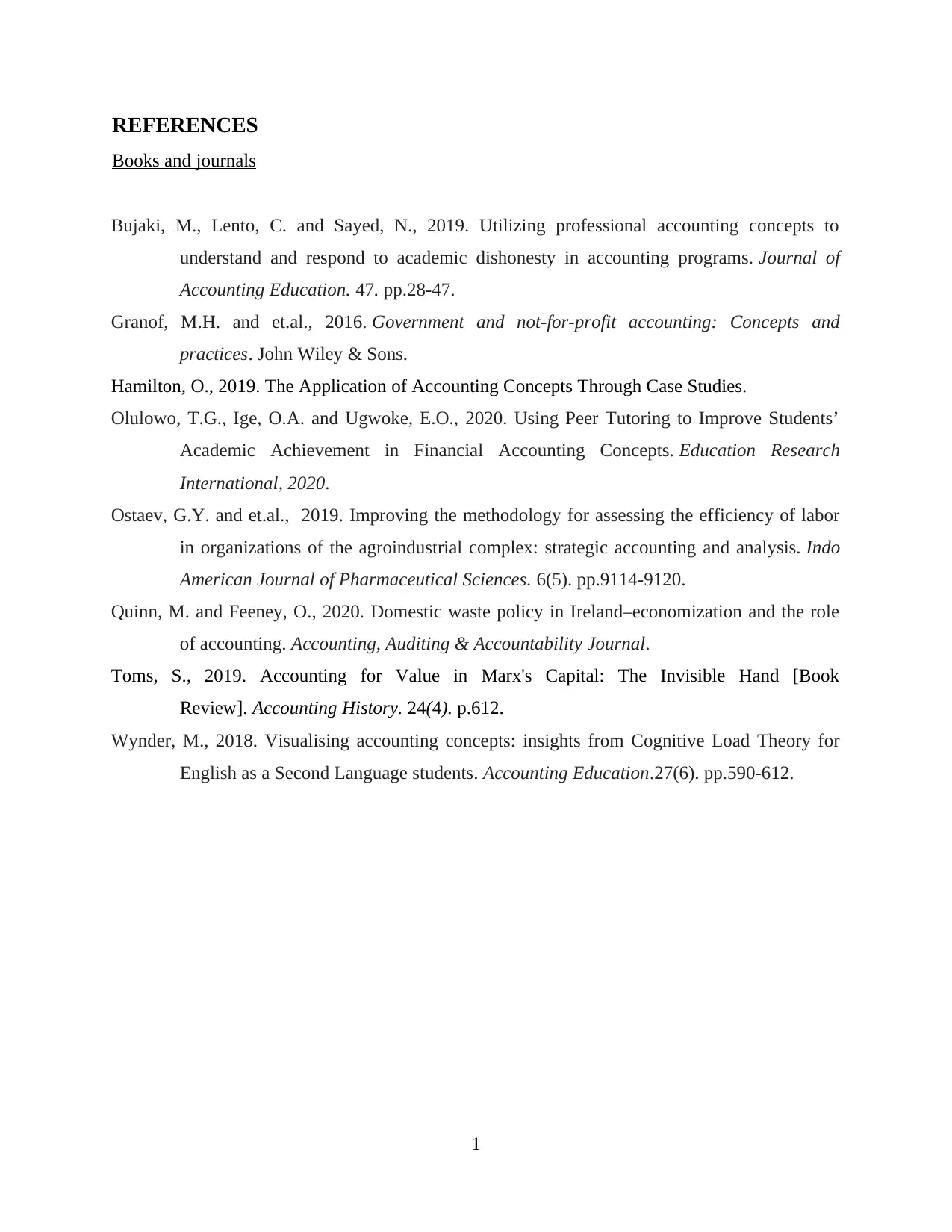
REFERENCES
Books and journals
Bujaki, M., Lento, C. and Sayed, N., 2019. Utilizing professional accounting concepts to
understand and respond to academic dishonesty in accounting programs. Journal of
Accounting Education. 47. pp.28-47.
Granof, M.H. and et.al., 2016. Government and not-for-profit accounting: Concepts and
practices. John Wiley & Sons.
Hamilton, O., 2019. The Application of Accounting Concepts Through Case Studies.
Olulowo, T.G., Ige, O.A. and Ugwoke, E.O., 2020. Using Peer Tutoring to Improve Students’
Academic Achievement in Financial Accounting Concepts. Education Research
International, 2020.
Ostaev, G.Y. and et.al., 2019. Improving the methodology for assessing the efficiency of labor
in organizations of the agroindustrial complex: strategic accounting and analysis. Indo
American Journal of Pharmaceutical Sciences. 6(5). pp.9114-9120.
Quinn, M. and Feeney, O., 2020. Domestic waste policy in Ireland–economization and the role
of accounting. Accounting, Auditing & Accountability Journal.
Toms, S., 2019. Accounting for Value in Marx's Capital: The Invisible Hand [Book
Review]. Accounting History. 24(4). p.612.
Wynder, M., 2018. Visualising accounting concepts: insights from Cognitive Load Theory for
English as a Second Language students. Accounting Education.27(6). pp.590-612.
1
Books and journals
Bujaki, M., Lento, C. and Sayed, N., 2019. Utilizing professional accounting concepts to
understand and respond to academic dishonesty in accounting programs. Journal of
Accounting Education. 47. pp.28-47.
Granof, M.H. and et.al., 2016. Government and not-for-profit accounting: Concepts and
practices. John Wiley & Sons.
Hamilton, O., 2019. The Application of Accounting Concepts Through Case Studies.
Olulowo, T.G., Ige, O.A. and Ugwoke, E.O., 2020. Using Peer Tutoring to Improve Students’
Academic Achievement in Financial Accounting Concepts. Education Research
International, 2020.
Ostaev, G.Y. and et.al., 2019. Improving the methodology for assessing the efficiency of labor
in organizations of the agroindustrial complex: strategic accounting and analysis. Indo
American Journal of Pharmaceutical Sciences. 6(5). pp.9114-9120.
Quinn, M. and Feeney, O., 2020. Domestic waste policy in Ireland–economization and the role
of accounting. Accounting, Auditing & Accountability Journal.
Toms, S., 2019. Accounting for Value in Marx's Capital: The Invisible Hand [Book
Review]. Accounting History. 24(4). p.612.
Wynder, M., 2018. Visualising accounting concepts: insights from Cognitive Load Theory for
English as a Second Language students. Accounting Education.27(6). pp.590-612.
1

2
⊘ This is a preview!⊘
Do you want full access?
Subscribe today to unlock all pages.

Trusted by 1+ million students worldwide
1 out of 9
Related Documents
Your All-in-One AI-Powered Toolkit for Academic Success.
+13062052269
info@desklib.com
Available 24*7 on WhatsApp / Email
![[object Object]](/_next/static/media/star-bottom.7253800d.svg)
Unlock your academic potential
Copyright © 2020–2025 A2Z Services. All Rights Reserved. Developed and managed by ZUCOL.



